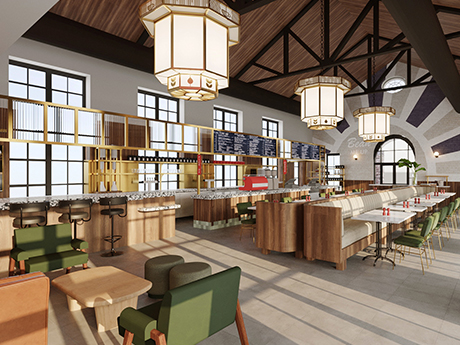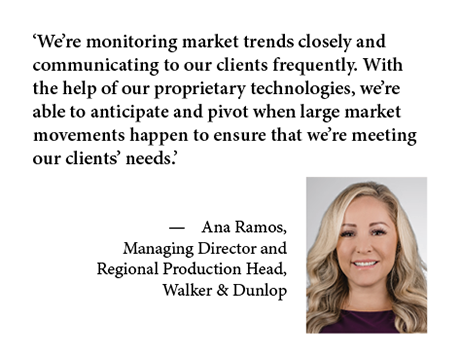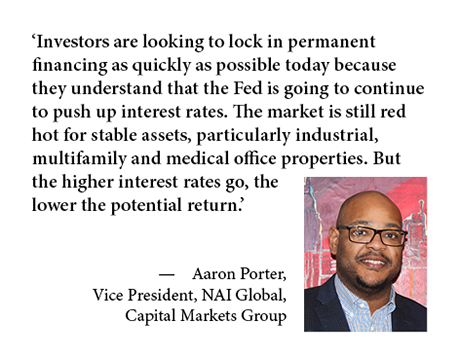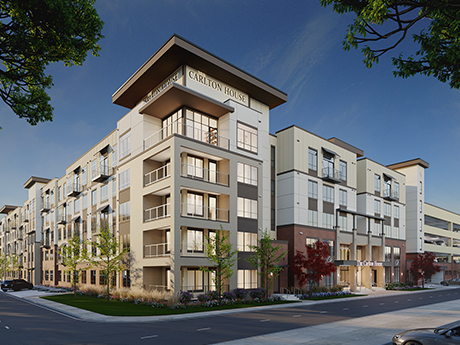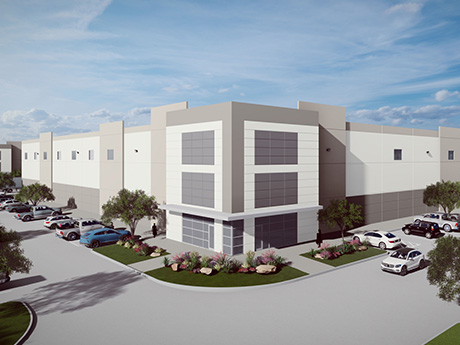Although the pandemic wreaked havoc on the retail sector in general, the culling of weak concepts has left space for strong retailers to flourish. The retail industry is seeing an explosion in experiential retail, medical/dental space is ubiquitous and non-traditional tenants are jumping at opportunities to secure prime locations. As a result, shopping centers have proven very resilient, says George Macoubray, vice president of retail brokerage with NAI Elliott in Portland, Oregon. “Today’s centers continue to evolve and to address what consumers need in terms of a place for people to congregate and participate in the activities that are important to them.” The entertainment sector was hit hard by the pandemic, he notes. “But now those operators seem to be out looking for locations, and they’re seeing the light at the end of the tunnel. People want to gather. They want to be entertained. They want to go out and do activities. Those kinds of experiences are happening more and more often in shopping centers — and you can’t buy those activities on Amazon.” Exciting new in-person experiences are helping to elevate shopping centers. “There’s an influx of experiential retail. From golf simulator experiences to ping-pong places to axe-throwing activities, …
Features
Content PartnerFeaturesLeasing ActivityMidwestMixed-UseNAINortheastRestaurantRetailSoutheastTexasWestern
By Taylor Williams Well before a global pandemic barreled through the nation, destroying the jobs, savings and legacies of thousands of American businesses, launching a new restaurant was still a daunting task. According to 2021 data from National Restaurant Association, 30 percent of U.S. restaurants fail within their first year of opening. Relentless competition, high employee turnover, razor-thin margins, misfired marketing campaigns — all represent major operating minefields that come with such ventures. The industry is not for faint-of-heart entrepreneurs, and even with the aid of a healthy economy, a talented and experienced operator and a prime location, there are no guarantees of success. One might think that with COVID-19 causing food and beverage (F&B) businesses to fail and sending vacated spaces back to the market, finding quality locations at affordable rates would be feasible in the current environment. But that’s hardly the case in many major cities, especially those in states that implemented life-saving initiatives for its F&B operators early in the pandemic and has been “back to normal” for some time. Minimal Vacancy While F&B markets across numerous states are flush with pent-up consumer demand to eat, drink and socialize, the logistical and financial challenges of launching …
Capitalizing on a changing marketplace and employing technology to streamline processes are essential strategies in helping small balance clients meet their goals. Ana Ramos, managing director and regional production head at Walker & Dunlop, emphasizes the importance of speed, creativity and using technology to assist in mortgage lending processes. She also emphasizes the centrality of teamwork, company ethos and technology to put a big emphasis on small balance loans. Walker & Dunlop defines “small loan” as up to $15 million for multifamily properties with five or more units. These clients are usually composed of smaller individual investors who need attention and education when it comes to mortgage lending. “It’s really hard for a large producer to think small, but it’s really easy for small producer to think big,” Ramos says. “It’s difficult for producers who are accustomed to institutional lending, with its higher fees and complex vesting structures to consider the credit parameters that are necessary in small balance loans. Small loans is a niche type of mortgage lending, and it only works if you have a company within a company, like Walker & Dunlop with its dedicated small loan team that works together through application, underwriting and closing.” Tech’s …
Content PartnerFeaturesHealthcareIndustrialLoansMidwestMultifamilyNAINortheastOfficeSoutheastTexasWestern
Rising Interest Rates and Inflation to Fuel Change in Property Markets
Beginning in the fourth quarter of 2020, commercial real estate buyers and sellers moved off the sidelines and began fueling an impressive investment sales rebound as many pandemic-related lockdowns and restrictions eased or ended. The rush to purchase hard assets hit its apex a year later when commercial property sales surged to a record $362 billion in the fourth quarter of 2021 alone, according to Real Capital Analytics, a part of MSCI Real Assets that tracks property transactions of $2.5 million or more. The strong market is continuing this year: Deals of $170.8 billion closed in the first quarter, a year-over-year increase of 56 percent, Real Capital reports. Buyers in the first quarter also pushed up prices 17.4 percent over the prior year, according to Real Capital’s Commercial Property Price Indices (CPPI). But given rising interest rates and other recent headwinds, will investors continue to drive robust investment activity and bid up prices? The 10-Year Treasury yield has spiked some 150 basis points to around 3 percent since the beginning of 2022, and fixed 10-year mortgage rates of between 3 percent and 4 percent are up about 100 basis points. For short-term variable loans, the benchmark secured overnight financing rate …
Affordable HousingBohlerBuild-to-RentContent PartnerDevelopmentFeaturesMidwestMultifamilyNortheastSingle-Family RentalSoutheastTexasWestern
Build-to-Rent Planning and Entitlements: How to Avoid Challenges
The build-to-rent (BTR) property type has gained significant traction in the commercial real estate market due to increasing interest from tenants, investors and developers. Developers moving into the BTR market before 2020 originally focused on this sector as an “in between” product for future home buyers who weren’t ready to commit to a single location but wanted additional space and amenities. The pandemic fueled tenants’ desires for more privacy and space without the long-term commitment of homeownership, which ignited growth in the sector. As costs for single-family homes continue to rise, the BTR niche also increasingly attracts would-be homeowners who are priced out of the homebuying market — and the growing demand for BTR properties draws the attention of more and more investors and developers. But not all stakeholders are immediately on board with development of BTR properties. The concept is rather new in some markets and local communities have questions about the zoning and operation of these hybrid communities, which are an intriguing mix of single-family concept and multifamily operations. Developers often need to educate municipalities about the BTR concept — and they need to plan BTR properties that work for the local community. This is where Bohler — a land …
By Taylor Williams As a subcategory of multifamily that is currently experiencing record rent growth, student housing is increasingly becoming a sought-after commodity in the world of institutional investment, according to a panel of industry experts. More institutional love for student housing is also arriving at a time in which concerns about COVID-19’s impact on enrollment and on-campus learning at the nation’s colleges and universities are largely being laid to rest. The verdict is in on whether students overwhelmingly prefer to live and learn on campus — they do. Capital sources are responding accordingly. At France Media’s 14th annual InterFace Student Housing conference, held May 3-4 at the J.W. Marriott Hotel Austin (Texas) Hotel, a group of industry veterans laid out the drivers behind the sector’s growth on institutional radars. As an affirmation of this trend, the “state of the industry” panel pointed to the $12.8 billion acquisition of Austin-based student housing developer and operator American Campus Communities (NYSE: ACC) by real estate giant Blackstone (NYSE: BX). Panelists implied that that deal, which was announced in April and will take ACC private, serves as a watershed moment for the asset class to institutional investors. As such, the transaction, which is …
By Greg Lyon, Chairman and Principal, Nadel Architects The appearance of retail is always evolving in terms of space and function. Today, however, it is becoming increasingly important to ensure a shopping center is the “place to be” in a community to achieve long-term success. This strategy allows developers to consistently deliver retail projects that attract crowds, encourage increased length of stay and repeat visits, and set the bar for the next evolution of retail. But how can retail designers work with developers to create this go-to destination within a community? Use Demographics, Psychographics to Inform Design Plans When you’re creating authenticity, you want to analyze not just a region’s demographics, but its psychographics as well. Every, single community is different and there is no one-size-fits-all approach when it comes to creating a center that resonates. For example, Trails at Silverdale, a 35-acre shopping and dining destination in Silverdale, Wash., speaks to the very distinct lifestyle of the region. Pacific Northwest shoppers enjoy the outdoors, are dedicated to sustainable living, and are drawn to authentic architectural elements that are innovative and youthful, while still conveying an elevated and sophisticated experience. Having a diverse, complementary mix of tenants, programmed common areas, pop-up experiences, and experiential retail alongside traditional tenants are …
By Taylor Williams The combination of dwindling vacancies and skyrocketing construction costs is beginning to have a marginally negative impact on the confidence that industrial brokers across major U.S. markets have in their chosen property type, according to the latest sentiment report from the Society of Industrial & Office Realtors (SIOR). For the first time in the report’s history, the average sentiment of industrial brokers that carry the designation, while still very bullish overall, dropped below eight on a scale of one to 10. Specifically, overall sentiment fell from 8.2 in the fourth quarter of 2021 to 7.7 in the first quarter of 2022. The report also identified an environment of rising interest rates as an additional detractor on industry sentiment, though that factor is not unique to the industrial sector. With industrial users heavily investing in their supply chains amid the pandemic and e-commerce boom, there’s simply very little Class A space to be had, especially within infill locations in core markets. Disruptions within those same supply chains have helped drive costs of construction materials and timelines for projects to way-above-average levels, putting further downward pressure on supply growth. As a result, overall industrial leasing activity has slowed. According …
Investment in Student Housing Remains Robust Despite Volatility in Debt, Equity Markets, Says InterFace Panel
by Katie Sloan
AUSTIN, TEXAS — As we move toward the start of a new academic year, the outlook in the student housing industry keeps getting brighter, according to experts within the industry. All signs point to further movement out of the COVID-19 pandemic — a testament to which was seen at the 14th annual InterFace Student Housing conference in Austin, where over 1,300 attendees gathered last week at the JW Marriott downtown. The sector’s resilience during the pandemic was once again a major topic at this year’s conference, particularly during the ‘Power Panel,’ which brought together a consortium of high-level executives to discuss industry trends and the outlook for the upcoming academic year. “Evidenced once again by a packed house in this room, the sector is demonstrating continued strength, resilience and sustainability as a niche real estate asset class,” began moderator Peter Katz, executive director with Institutional Property Advisors (IPA), a division of Marcus & Millichap. “While 2021 was a record year for many asset classes, one constant that we can expect in life is change,” he continued. “Over the past 90 days, we’ve seen a huge turn of events in the global economic platform. The impact of the COVID-19 pandemic has …
Affordable HousingFeaturesMidwestMultifamilyNortheastSeniors HousingSoutheastStudent HousingTexasWestern
Four Ways Technology Can Keep Onsite Multifamily Staff Happier During the Great Resignation
by Jaime Lackey
The Great Resignation. The Big Quit. Call it what you will. The widespread trend of employees leaving their jobs in 2021 and 2022 has placed a burden on onsite property management staff at multifamily communities. Like other industries nationwide, the multifamily industry has been hit hard by this period where record numbers of employees are leaving their current positions. According to the National Apartment Association (NAA), rental owners and operators have reported up to 70 percent of their workforce resigning during this period. Historically, employee turnover ranges from 30 to 50 percent annually. In roles that often require wearing many hats to keep up with prospective renters and resident requests, leasing teams are feeling added pressure. With technology solutions that alleviate daunting tasks for onsite staff, you can save your staff valuable time and unnecessary manual effort. Your leasing team can simplify tour scheduling, automate routine communications, and set up seamless multifamily marketing campaigns that free up time for staff to better connect with renters. Here are four steps operators can take to maximize efficiencies and achieve better outcomes. 1. Automate Apartment Tour Scheduling The first step to helping your team thrive during a spike in renter demand is understanding …



